Working to bring Gavialis gangeticus back from the brink of extinction.
Long narrow jaws, a toothy smile and eyes that sit on top of its skull like glassy marbles all contribute to the gharial crocodile (Gavialis gangeticus) as being the most recognizable of all the crocodilians on the planet.
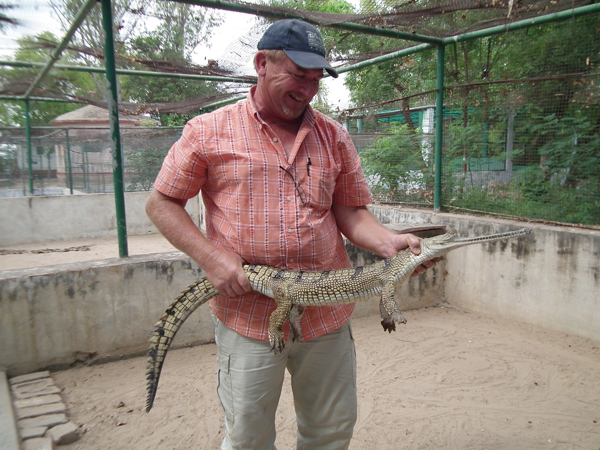
Lonnie McCaskill
The author admires a young gharial.
Males can be some of the largest individuals among all crocodilian species. A few have measured 20 feet in length, and a skull in Deori, India, is said to have come from an adult male that was 21 feet long and that drowned in a fishing net. Females are much smaller, reaching about 9 to 12 feet. Along with the distinct ghara (meaning “earthen pot”)-like bulbous structure on its nose, this amazing animal truly stands out, and the gharial has become a cultural figure throughout its range. Once found in India, Pakistan, Myanmar and Nepal, it is now restricted to India and Nepal, in mostly fragmented populations, with one of the largest being in the Chambal River.
A strict fish eater, the gharial poses no threat to the indigenous people within its habitat who utilize the same waters as a way of life, almost as much as the gharial. A symbol of folklore, myth and legend, one would think this alone would be enough to ensure the survival of such an incredible animal. However, both the growing human population and the struggle for resources—from the waters in which the gharial lives to the sand bars where it nests—have greatly reduced the croc’s numbers throughout its historic range. The tragic sudden die off of more than a hundred gharials several years ago threatened its survival, and this iconic crocodilian continues to be pushed to the edge of extinction.
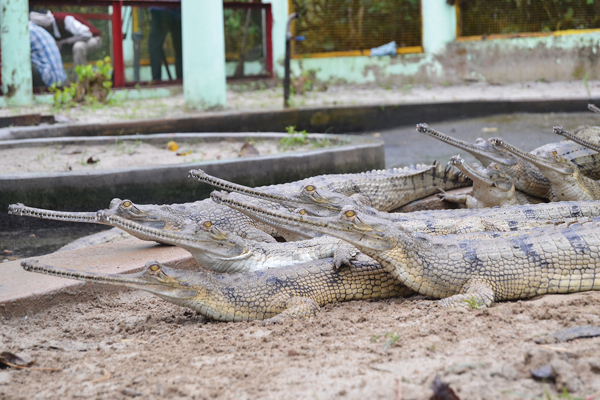
LONNIE MCCASKILL
Sixty-two gharials from the Kukrail Gharial Breeding Facility in Lucknow were the animals that were initially released in 2012. In 2015, 62 additional gharials were released at the same site.
For many years, India has maintained breeding and rearing facilities for head starting and restocking the gharial, but these efforts alone have not been able to keep up with losses from incidental drownings in fishing nets and the destruction of key nesting areas for the valuable sand that is used for construction in this growing country. Some of these activities occur in protected areas, too, which are almost impossible to regulate.
Gavialis gangeticus is currently listed as critically endangered on the Red List of the International Union for the Conservation of Nature (IUCN). Yet, with some key conservation actions and support from international funding, the gharial keeps holding on, because crocs are survivors!
Gharial Breeding Habits
New information about the gharial’s natural history is coming to light thanks to the focused research of people like Professor Jeffrey W. Lang and his Indian research staff. Many secrets of the croc’s daily life have been revealed, which are key in identifying conservation strategies, including areas vital for habitat protection and restocking efforts. Without this new research, conservation and restocking by merely releasing animals into rivers along the animal’s range would remain a shot in the dark. Very important life-cycle history has been discovered that will play a major role in future conservation action plans.
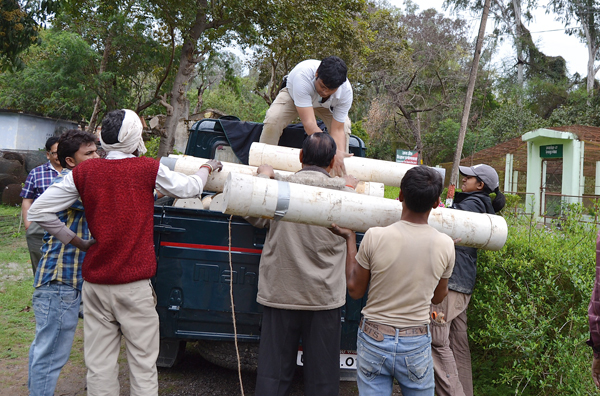
LONNIE MCCASKILL
For transport to the release site, the gharials were placed in these tubes.
One vital discovery notes the reproductive strategies and hatchling care from both the females and the dominant male. Gharials are very protective, nurturing parents from the time their hatchlings emerge to the beginning of the rainy season, when rivers begin to swell and the hatchlings are dispersed into the rising water levels.
Typically at the start of the breeding season, a dominant male claims a section of a river where there are several females. These areas usually comprise deep-water pools and high sand banks left over from the previous year’s flooding season. As the season begins, the males begin routine patrolling an area, pushing out lesser males while eyeing and flirting with the females. Such rituals normally occur in the morning and during the last few hours of the day, and it is a sight to see from the bluffs overlooking the Chambal River!
Females will lie in the shallows or bask on the sand bars adjacent to the deep pools, and the maale will approach one and display—with body positioning and jaw slaps that sound like gunshots—looking for signs of interest, before moving on to the another if he gets a cold shoulder.
Males don’t necessarily do all the courting. Females can also be instigators, following a male as he patrols and nudging him along. The male may use the shallows between the sand bank and river’s edge as he makes his rounds, and as he gets to the end of the line, often he will circle around by submerging on the deep side of the sand bar and navigating back to where he started so he can start over.
This behavior continues for several weeks until there are number of gravid females that are ready to nest. Gharial females tend to use the same high sand banks for nesting and are considered communal nesters, occasionally digging nesting holes within feet of one another. These areas are often next to still water pools at the edge of the main river channel, and on their banks can also be found nests of the three-striped river terrapin (Batagur dhongoka) and the red-crowned roof turtle (B. kachuga)—this is a smart strategy for the turtles, placing their nests near or among defensive crocodile males and females!
As the gharial eggs begin to hatch, the babies emerge and slide down the bank into the still waters of the pool where the dominant male and the females are awaiting their arrival. After all the nests have hatched, it is not unusual to see several hundred babies in the pools, creating living rafts of hatchlings that frequently use the males and females as basking logs. The nursery area for baby gharials is normally a shallow, sandy cove at the bottom of a high sand bar. Because vegetation is scarce there is little or no protection for hatchlings, other than that provided by the parents, or perhaps a fallen tree from the previous year’s floods that offers some cover.
Dr. Lang has documented parental behavior of males and females, both day and night, with some surprising discoveries, and their feeding and protection of the young and other intimate details of parental care reveals a species that proves to me much more than just a bizarre-looking crocodile.
A Model Release Program
With many secrets being revealed about the beginning of the gharial life cycle and more about their ecology, new ideas and methods are being explored to improve the survivability of restocking programs. One such plan originated with the reintroduction of Siamese crocodiles (Crocodylus siamensis) in Cambodia.
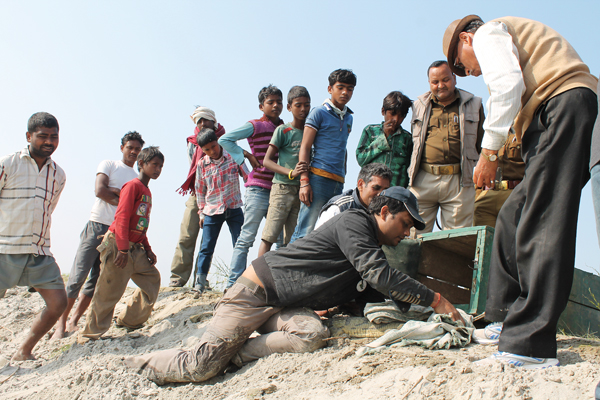
LONNIE MCCASKILL
Onlookers observe as Dr. Singh prepares to release one of the gharials.
I have been involved with Siamese crocodile conservation, partnering with Fauna and Flora International (FFI) and the Wildlife Conservation Society (WCS) since 2004. The species, once thought to be extinct, was rediscovered in 1997 by a FFI conservation team and a solid conservation and recovery plan was developed. Between 1997 and 2004, small populations of Siamese crocodiles were located within Cambodia. Historical habitats were surveyed for possible reintroduction, and communities were interviewed to gauge their acceptance of crocodiles being introduced back into the area.
A group of captive animals was acquired over time for reintroduction, and in 2012 18 Siamese crocodiles were ready to be reintroduced back into the wild for the first time. The site location for the reintroduction was very remote and transport was a bit of a logistical challenge. Prior to the release date, FFI staff prepared a site incorporating a fenced area of the river and shore that would allow the animals to recover from their long ride, and to acclimate to their new habitat after being in captivity. Crocs in captivity lose their instinctive fear of people, and most raised in captivity will sit in plain sight when approached, and not flee like wild crocs do. They also tend to lose some of the swimming skills needed to negotiate deep, moving water. By placing them into the fenced-in area of the river we hoped they would regain these wild behaviors before being set free.
After being fitted with radio transmitters for post-release monitoring, the 18 crocs were placed into their transport containers for an all-night ride, and a second leg the next morning by motorbike that took us deeper into croc habitat.
My colleague and friend from the Turtle Survival Alliance (TSA) India program, Dr. Shailendra Singh, was able to join me on this trip to help. The plan was to leave the Siamese crocs in the pen within the river for 10 days before releasing them. As expected, they were snappy and tired from the trip, and after release into the pen they quickly submerged to various hiding spots in the enclosure. After releasing them all, we quickly retreated back to the main camp, leaving the crocs alone to settle down.
The next morning I went to check on them, and when I peeked over the fence, the animals that were on land bolted for the water and quickly disappeared. This was exactly what I was hoping to see! As the days went by, they could scarcely be caught on land at all, obviously having heard our approach and quickly rushing for the safety of the water. We were greatly satisfied to see the Siamese crocs were so quickly regaining the behavior they would need for survival upon being released.
Gharials Released
Later, back home in India, Dr. Singh discussed the Siamese crocodile reintoductions with wildlife officials Dr. Rupak De, Principal Chief Conservator of Forests, and Sanjay Srivastava, Conservator of Forests and Endangered Species, Uttar Pradesh, and afterward was asked to arrange a similar type of release program for the gharial in northern India’s Terai region on the Ghaghara River, among the foothills of the Himalayas. The Ghaghara is a fast-flowing river just below Katerniaghat Wildlife Sanctuary along the Indo-Nepal border.
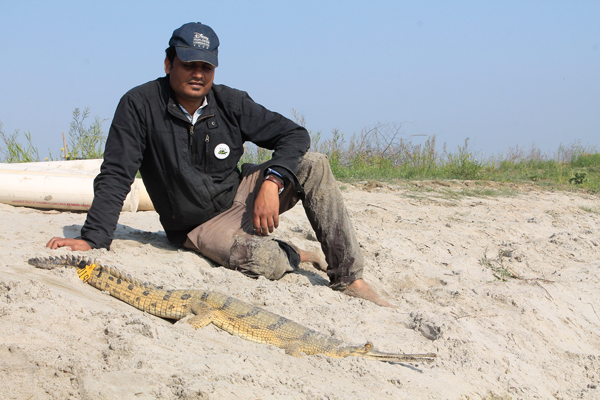
Lonnie McCaskill
A gharial makes its way down to the water.
Sixty-two gharials that were being kept at the Kukrail Gharial Breeding Facility in Lucknow (the capital of Uttar Pradesh) were selected. Half would be released into a fenced-off backwater of the Ghaghara River, and half would be set free directly into the river, next to the “soft-release” pen.
Prior to the release, Dr. Lang traveled to Kukrail to assist in attaching radio-tracking transmitters to 10 gharials, five that would go into the pen and five that would be released into the river. The rest of the crocs had distinctive tags attached to their tails so they could be easily identified from a distance. Staff from the Turtle Survival Alliance monitored the animals after the release for the first year, while conducting turtle surveys and monitoring in the same area of the river.
Earlier this year, 62 additional gharials were released at the site. Preliminary findings as a result of monitoring indicate a survival rate of more than 50 percent among the released 124 gharials, and their dispersal over approximately 62 miles on either side of the release site. The research team has also identified a few additional wild gharials inhabiting the Ghaghara.
Gharial Conservation Efforts
Funding for conservation projects like this can be expensive and difficult to obtain. The Disney Conservation Fund (DCF [TSA India]), Wildlife Conservation Society (WCS) and the organizers of Croc Fest in the United States and Canada (facebook.com/SaveTheCrocs) provided funding for the relocation of the gharials, as well as their monitoring, as well as the construction of an environmental education center along the river in Terai, to help educate local communities about the importance of local wildlife and aquatic ecosystems, and to dispel myths about the gharial, such as that they eat all the fish in the rivers. Water conservation, agriculture methods and sustainable bi-catch friendly fishing techniques are also taught at the center, and the education of primary school children about the importance of ecosystems is a priority, as well. The center will be instrumental in educating the next generation of people in the area on how to conserve and protect the waterways that are vital to their survival.
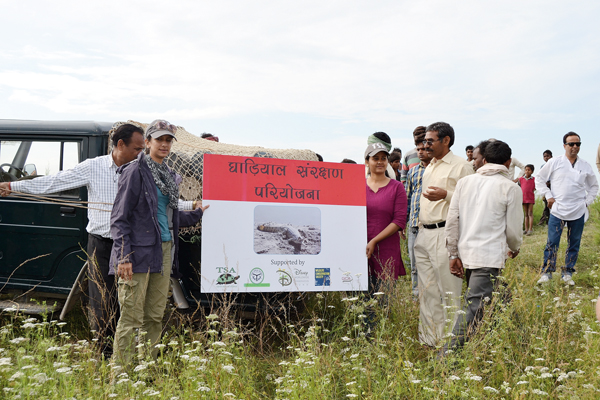
Lonnie McCaskill
A release of gharials and the supporters who helped make it happen.
Many of the programs being taught at this center originated from another center the TSA built along the Chambal River, where the TSA and Dr. Lang conduct turtle and gharial conservation projects side by side in a joint partnership to make the most efficient use of grant and support funding. It’s partnerships such as this that have proven to be successful in remote regions around the world. Clear conservation goals, a holistic approach to working with local communities and demonstrating how protecting wildlife and the aquatic ecosystem benefits them, as well as area wildlife for generations to come, are the essential components that form a successful conservation program.
There is still a long way to go and much to be learned to ensure the survival of the gharial throughout India and Nepal. As research continues, release methods will be explored and refined, and fishing communities will continue to be involved and engaged, which will greatly aid the species’ long-term survival. If these programs can continue to receive support from local and international organizations through funding and assistance, the future does look bright for this amazing croc!
The author would like to thank Professor Jeffrey Lang, Dr. Shailendra Singh and Mary Ann Lock for their input during the writing of this article.
Lonnie McCaskill began his zoo career at the Dallas Zoo in 1984, and in 1994 moved to Florida to work at the White Oak Conservation Center. He was later a member of the opening team at Disney’s Animal Kingdom in Orlando, where he was a zoological manager from 1997 until 2014. He serves on the AZA Crocodile Advisory Group steering committee and the Turtle Survival Alliance board of directors, and is also an IUCN Crocodile Specialist Group co-chair for Southeast Asia.


